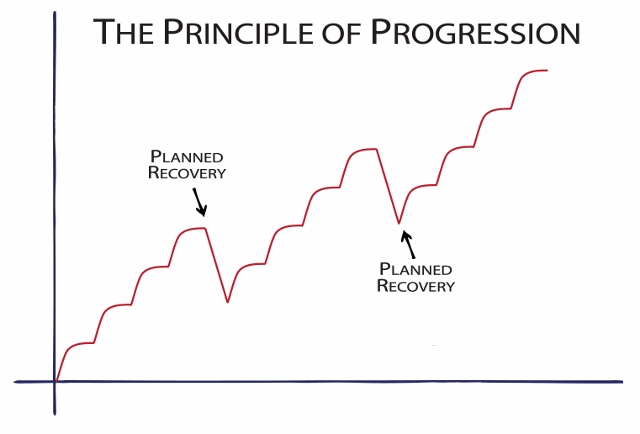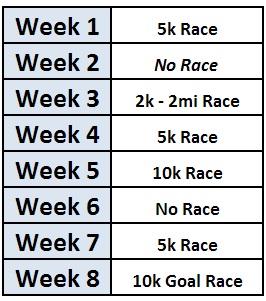I love passionate runners who have so many goals they just can’t wait to train hard. The enthusiasm is infectious.
Their short list includes things like:
- run a 40+ mile week
- complete a marathon
- run an obstacle race
- consistently do strength work after every run
- race a 3min PR in the half marathon
Each one of these training and racing goals will help you develop as a runner, building the strength and speed you need to run well at any race distance.
But it’s critical to prioritize some goals over others so your fitness continues to improve. If you’re jumping from marathon workouts to 5k workouts and short weeks to heavy-volume weeks, your training won’t progress in the direction it should.
Remember the Principle of Progression?

Your fitness and readiness to run new personal bests will ebb and flow throughout the year as you can see from the peaks and valleys in the graph. Good training should cycle from easy to moderate to difficult to allow yourself to recover and get even faster.
This strategy also helps you prevent more injuries as you’re never starting from scratch – you’re building on what you’ve done before. And as Brad Hudson notes in his book Run Faster, injuries tend to happen during periods of heavy mileage increases. It’s not necessarily the high mileage, it’s the journey to get to the higher volumes that can be dangerous.
So for this reason, you can’t prioritize two race distances at the same time. But you can definitely come close.
How to Train for Two Race Distances – the Tune-up Approach
Running a “tune-up” – or a race that helps you prepare for a more important race later – is the most common way to schedule multiple races. This strategy is most helpful when your goal race is longer, like a half-marathon or marathon.
So what tune-up race distances are good for the marathon? The most traditional distance is a half marathon, usually scheduled 4-6 weeks before your marathon.
Since the marathon requires such strict training, you’ll be racing your HM off marathon fitness. In other words, you won’t do any specific half marathon workouts. But since you’re likely in great shape from marathon training, you’ll probably run great. The goals of a HM tune-up are numerous:
- Practice your race day routine
- Get an accurate indication of your progress and current fitness level
- Perform a challenging, mostly aerobic race that’s more specific to the marathon than any other traditional race
When you add a half to your marathon schedule, the only thing you’ll change is that you may need a few days before and after to rest and recover so that you can jump back into your marathon preparation. Otherwise, train right through the HM.
And if you’re training for a half marathon, the best tune-up distance is 10k (though you can run more races than if your goal race was a marathon – so your tune-up schedule could include a bunch of races).
You’ll realize the same goals as racing a half marathon during marathon training and you probably don’t want to taper and take significant recovery after the 10k. So keep on training right through the race!
Planning a “Race Season”

First, be sure to use our free Season Planner worksheet!
Some runners fall into the trap of training for only one race distance multiple times a year.
Most commonly it’s the marathon, which forces you to focus on the same type of training year-round.
But shorter races are much easier to recover from so you can schedule them very close together, essentially creating a “race season.” With the right planning, you can have 4-8 weeks of races that’s similar to how college track athletes race!
With this approach, you’ll still need a goal or “A” race as your primary focus for the whole season. But during the 4-8 weeks beforehand, you can include races that help you prepare.
This strategy is very similar to using support paces, though this time you’re using support races.
While you can go a little crazy with scheduling more frequent short races, I don’t recommend that runners do more than one race per week or more than one 10k every other week. If you’re racing to your potential (i.e., as fast as you can go!), races are very stressful.
There’s a sample schedule on the right showing how a runner could schedule races in preparation for a 10k. Another option is to run a 5k in Week 3, a half marathon in Week 4, and then move the 10k to Week 6. The options are nearly endless but as long as proper recovery is planned, you should be ready to thrive from a good race season.
Half Marathon and Marathon Training
There’s another approach to take when your races are further apart that is even more productive because it allows you to prioritize both races.
I got this question via email from Tabitha:
I decided to train for a marathon 20 weeks after my half marathon. I was going to just increase my long run after the HM but that means I’d be well over 20 miles before the marathon. Is it better to start over as if I’m beginning a new training plan or keep going after the HM and just get in more long runs? I’d like to have more long runs so I’m comfortable with the distance but don’t want to over-train.
Her situation is actually a very good one: she has a great fitness foundation after training for a half marathon. The transition to marathon training is relatively simple once she recovers after her half marathon.
Tabitha should remember these four key principles as she plans her race schedule and training:
- Take 1-2 weeks after the HM to recover. For most people, this means no running and limited cross-training.
- Since your fitness is still high after HM training, you don’t have to start at ground zero. Start somewhere in the first third of a marathon training plan that’s similar to the second half of a HM training plan.
- 20 weeks is a long training plan so make sure to take 1-2 recovery weeks of reduced volume and intensity spaced throughout.
- Make injury prevention a priority since you’ll be running a lot for a relatively long time period.
This strategy allows you to prioritize both races while giving you enough time to rest after the half. When you’re able to combine rest with a progressively higher workload, you’re going to run fast.
Need some extra guidance? Get our free Season Planner to help you plan your tune-up races, the lenth of your plan, and more.
PS. PR Race Plans are back!
After two weeks of being closed, the custom training plan program is now open again. Many of you have emailed about this, so I’m thrilled to be back to work to help you become a better runner.
You can visit the race plan page here.